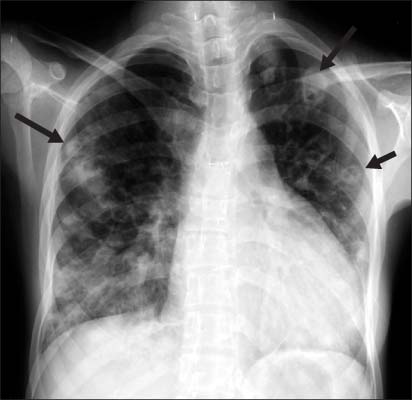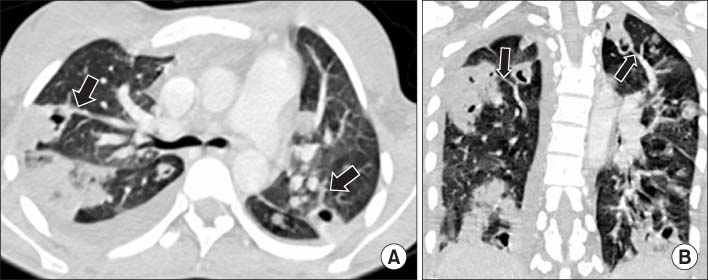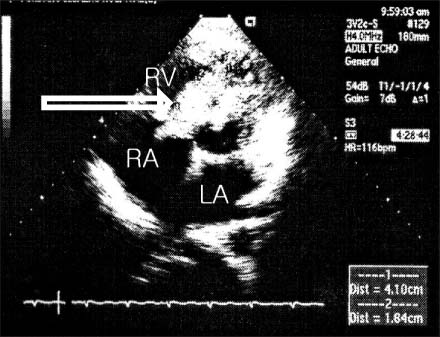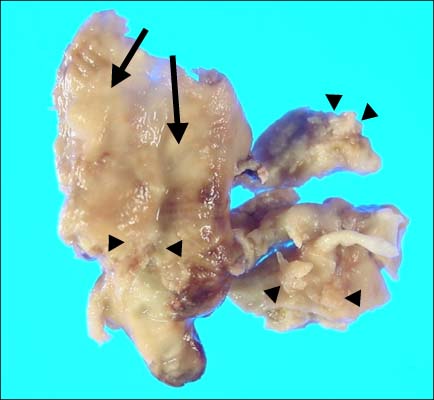Tuberc Respir Dis.
2010 Aug;69(2):124-128.
A Case of Septic Pulmonary Embolism Associated with MRSA Infective Endocarditis
- Affiliations
-
- 1Department of Internal Medicine, DMC Bundang Jesaeng Hospital, Seongnam, Korea. jychin@dmc.or.kr
- 2Department of Chest Surgery, DMC Bundang Jesaeng Hospital, Seongnam, Korea.
- 3Department of Diagnostic Radiology, DMC Bundang Jesaeng Hospital, Seongnam, Korea.
- 4Department of Radiology, Dongguk University Ilsan Hospital, Dongguk University College of Medicine, Goyang, Korea.
- 5Department of Anatomical Pathology, Hallym University College of Medicine, Seoul, Korea.
Abstract
- Septic pulmonary embolism is the process in which an infected thrombus becomes detached from its site of origin and lodges in a pulmonary artery, and is usually associated with infective endocarditis, especially right-sided, or infection-associated with indwelling catheters, peripheral septic thrombophlebitis, and periodontal diseases, etc. Here, we report a case of septic pulmonary embolism associated with tricuspid valve infective endocarditis. A 23-year-old female was admitted to our hospital, due to fever, sore throat, and myalgia. In her past medical history, she had undergone a surgical operation for closure of a ventricular septal defect, but was informed that the operation resulted in an incomplete closure. The initial chest radiograph demonstrated multiple rounded, parenchymal nodules in various sizes; several nodules had central lucency suggesting cavitations. Echocardiography demonstrated a large vegetation attached to the septal tricuspid valve leaflet, extending from right ventricular inflow tract to outflow tract. Computed tomography of thorax revealed bilateral peripheral nodules and wedge-shaped consolidation at various sizes, mostly accompanied by cavitations.
MeSH Terms
Figure
Reference
-
1. Fred HL, Harle TS. Septic pulmonary embolism. Am Fam Physician GP. 1970. 1:81–87.2. Cook RJ, Ashiton RW, Aughenbaugh GL, Ryu JH. Septic pulmonary embolism: presenting features and clinical course of 14 patients. Chest. 2005. 128:162–166.3. Huang RM, Naidich DP, Lubat E, Schinella R, Garay SM, McCauley DI. Septic pulmonary emboli: CT-radiographic correlation. AJR Am J Roentgenol. 1989. 153:41–45.4. Rossi SE, Goodman PC, Franquet T. Nonthrombotic pulmonary emboli. AJR Am J Roentgenol. 2000. 174:1499–1508.5. Karchmer AW. Libby P, Bonow RO, Mann DL, Zipes DP, editors. Chapter 63. Infective endocarditis. Braunwald's heart disease: a textbook of cardiovascular medicine. 2007. 8th ed. Philadelphia: Saunders Elsevier;1713–1738.6. Webb DW, Thadepalli H. Hemoptysis in patients with septic pulmonary infarcts from tricuspid endocarditis. Chest. 1979. 76:99–100.7. Han D, Lee KS, Franquet T, Müller NL, Kim TS, Kim H, et al. Thrombotic and nonthrombotic pulmonary arterial embolism: spectrum of imanging findings. Radiographics. 2003. 23:1521–1539.8. Kuhlman JE, Fishman EK, Teigen C. Pulmonary septic emboli: diagnosis with CT. Radiology. 1990. 174:211–213.
- Full Text Links
- Actions
-
Cited
- CITED
-
- Close
- Share
- Similar articles
-
- Mechanical Thrombectomy for Septic Embolism Secondary to Staphylococcus lugdunensis Bacteremia without Infective Endocarditis: A Case Report
- A Case of Hemophilus Paraphrophilus Endocarditis with Cerebral Embolism and Hemorrhage
- A Case of Tricuspid Valve Endocarditis with Pulmonary Embolism in a Drug Addict
- Acute Pulmonary Embolism Caused by Subacute Infective Endocarditis of the Tricuspid Valve
- A Case of Right Ventricular Infundibular and Pulmonic Valve Infective Endocarditis






